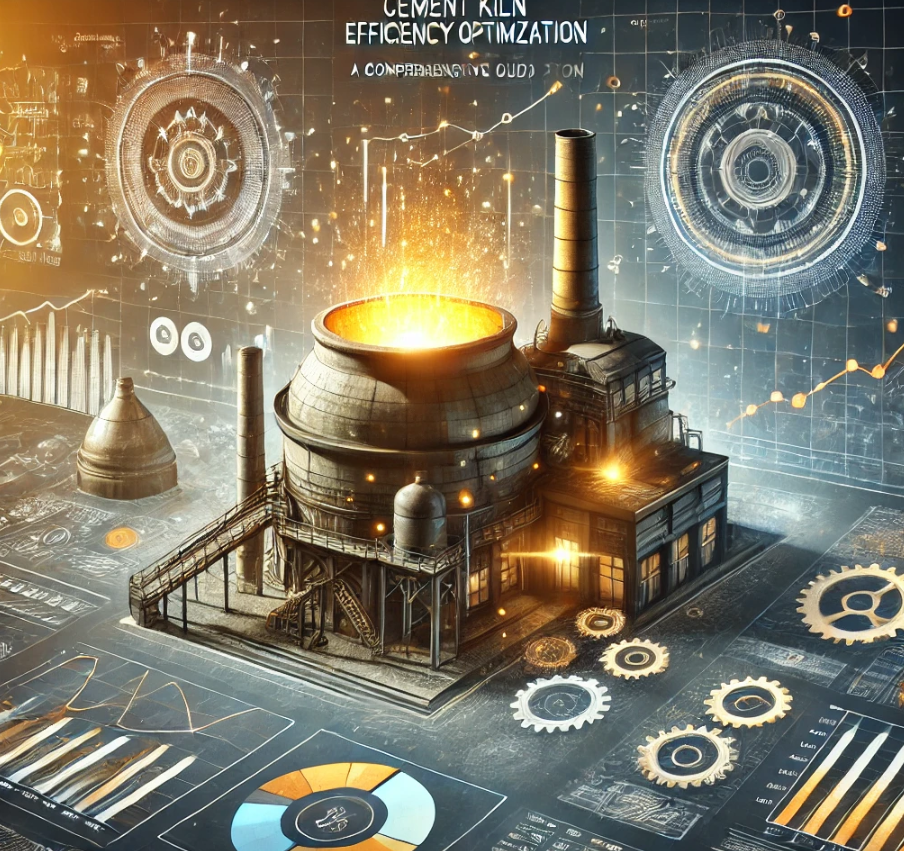Contents
Cement Kiln Efficiency Optimization: A Comprehensive Guide to Maximizing Performance

TO Download this post and all the books and excel sheets and my personal notes and presentations I collected about cement industry in the last 30 years click the below paypal link
Introduction
Cement kiln efficiency is a critical factor in cement production, influencing both the environmental impact and profitability of the operation. As the industry faces increasing pressure to reduce carbon emissions and improve energy efficiency, optimizing kiln performance has become a top priority for cement plant operators. This guide provides a detailed overview of the techniques and technologies that can significantly enhance the efficiency of cement kilns.
Understanding Cement Kiln Efficiency
Cement kiln efficiency refers to the ratio of energy input to the useful energy output in the form of clinker. Improving this efficiency means maximizing the amount of clinker produced per unit of energy while minimizing waste and emissions. Several factors affect kiln efficiency, including the design of the kiln, the type of fuel used, and the control systems in place.
Key Factors Influencing Kiln Efficiency
- Kiln Design and Configuration
- The design of the kiln, including its length, diameter, and inclination, plays a vital role in determining its efficiency. Modern kilns are designed to optimize heat transfer and minimize heat loss, resulting in higher efficiency.
- Preheaters and Precalciners: Installing multi-stage preheaters and precalciners can significantly improve thermal efficiency by preheating the raw materials before they enter the kiln, reducing the amount of energy required for clinker formation.
- Advanced Heat Recovery Systems
- Waste Heat Recovery (WHR): Implementing waste heat recovery systems can capture and reuse heat from the kiln exhaust gases, reducing the overall energy consumption. WHR systems can be used to generate electricity or preheat raw materials.
- Heat Exchangers: Modern heat exchangers are designed to maximize heat transfer between the kiln gases and the raw materials, improving the thermal efficiency of the process.
- Fuel Selection and Combustion Control
- Alternative Fuels: The use of alternative fuels, such as biomass or waste-derived fuels, can improve kiln efficiency by providing a more consistent and controlled heat source. Additionally, these fuels often have a lower carbon footprint, contributing to sustainability goals.
- Combustion Optimization: Advanced combustion control systems can optimize the air-to-fuel ratio, ensuring complete combustion and reducing energy wastage. This also helps in minimizing the formation of harmful emissions like NOx.
- Modern Control Strategies
- Advanced Process Control (APC): APC systems use real-time data and predictive algorithms to optimize kiln operation. By continuously monitoring key parameters such as temperature, pressure, and feed rate, APC systems can make adjustments that enhance efficiency and stability.
- Kiln Automation: Automation technologies allow for precise control of the kiln’s operating conditions, reducing human error and improving consistency in production. Automated systems can also optimize fuel usage and reduce downtime.
- Maintenance and Monitoring
- Predictive Maintenance: Regular maintenance is crucial for ensuring optimal kiln performance. Predictive maintenance technologies, such as vibration analysis and thermography, can detect potential issues before they lead to costly breakdowns.
- Real-Time Monitoring: Continuous monitoring of kiln performance using sensors and data analytics helps identify inefficiencies and areas for improvement. Real-time data can be used to make immediate adjustments, preventing energy losses.
Case Studies: Real-Life Examples of Kiln Efficiency Optimization
- Case Study 1: Heat Recovery in a European Cement Plant
- A European cement plant implemented a waste heat recovery system that captured exhaust gases from the kiln and used them to generate electricity. This resulted in a 15% reduction in energy consumption and a significant decrease in CO2 emissions.
- Case Study 2: APC Implementation in an Asian Cement Plant
- An Asian cement plant deployed an advanced process control system to optimize kiln operation. The system improved clinker quality and reduced energy consumption by 10%, leading to substantial cost savings.
Environmental and Economic Benefits of Kiln Efficiency Optimization
Optimizing cement kiln efficiency not only enhances production capacity but also contributes to environmental sustainability. By reducing energy consumption, plants can lower their carbon footprint and meet regulatory requirements. Additionally, improved efficiency translates into lower operating costs, making the cement production process more economically viable.
Conclusion
Cement kiln efficiency optimization is a crucial aspect of modern cement production. By adopting advanced technologies and best practices, cement plants can achieve significant improvements in energy efficiency, reduce emissions, and enhance profitability. As the industry continues to evolve, staying ahead with the latest innovations in kiln efficiency will be key to maintaining competitive advantage.
Call to Action
For cement industry professionals looking to optimize their kiln operations, investing in the right technologies and strategies is essential. Explore our range of solutions designed to enhance kiln efficiency and drive sustainable production. Contact us today to learn more.
TO Download this post and all the books and excel sheets and my personal notes and presentations I collected about cement industry in the last 30 years click the below paypal link
